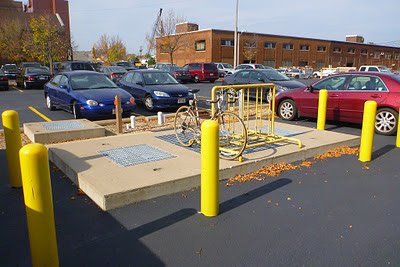Rain gardens are supposed to put runoff back into the ground.
But they don't do their job if the runoff never gets into them, if they overflow before the water sinks in, or if their bottoms are impervious. I'll address the first two issues here.
Many large rain gardens--for example, those taking runoff from parking areas--aren't graded properly. The runoff never gets into them. Obviously, no one is checking to see if they really work. I'll give three examples from parking lots.
Metcalfe's Sentry
In this large lot, there are 3-4 long islands between rows of parking, which are supposed to receive runoff from the gutters through gaps in the curb.

These gardens fail because the basins aren't much lower than the gutter. No water flows in.

And, there is nothing to deflect the swift flow in the gutter towards the garden.
Madison Gas & Electric visitor's parking
At this lot, we have--at the center of the lot--a filtration chamber. It was designed to filter the toxic stuff dripping from vehicles, before the runoff gets to nearby Lake Monona. The filtration was a cooperative project by MG&E, DNR, and other agencies to see how efficient filtration could be.
The filters reside in an underground concrete bunker--the setup cost $50,000. It basically does the job a larger rain garden could do.
While this wasn't a rain garden, they did measure how effective the parking area was at gathering water and feeding it to the filters. Since the parking area wasn't graded to be an effective catchment basin, it sent 30% of the water to surrounding streets. Only 70% of the water falling on the pavement actually went to the filters.
The area within the red line drained to the filters. The area between the red and yellow lines drained to the street--wasted.
So a rain garden (or filtration system) is no more effective than the grading and inlets to the garden. If the grading isn't carefully done, you've wasted a lot of money.
Terrace rain gardens on Eaton Ridge
These were among the first rain gardens on terraces, built by the City.
Rain garden inlets on Eaton Ridge were too small, and quickly became clogged.
Terrace gardens built by the City on Adams St had better entrances.
Sequoya Commons
 This is a beautiful rain garden, with a large capacity. For the most part, it is well-graded. Nevertheless, a small portion of the north end of the parking area drains to the street, via the entrance to the lot.
This is a beautiful rain garden, with a large capacity. For the most part, it is well-graded. Nevertheless, a small portion of the north end of the parking area drains to the street, via the entrance to the lot.My real purpose for mentioning Sequoya is that you can see this garden does reject some water. I saw if overflow once in a heavy storm.

On another occasion, when the garden was full of water, a steady stream of clear water seeped from the garden into the storm sewer. While this escaping water didn't get into the ground, at least it was clean and free from sediment.
The bottom line
The bottom line
Before you build a garden, always watch where the rain goes during a storm.
Test the grade by pouring water on the pavement.
Don't pay the contractor till you see if the garden actually works.
If necessary, build a berm of earth or asphalt to correct the flow.



















